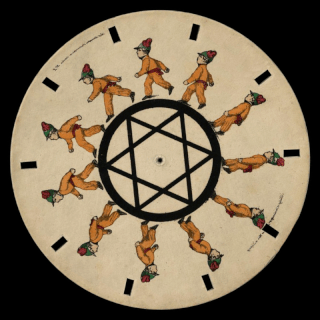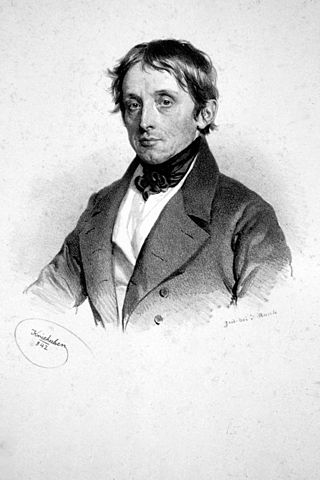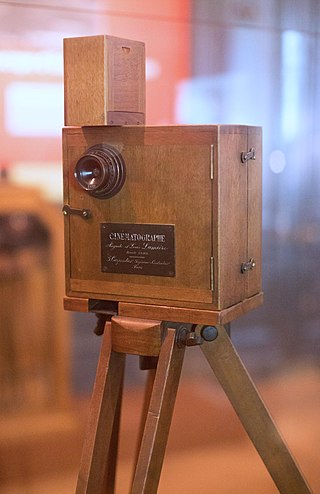Related Research Articles

The magic lantern, also known by its Latin name lanterna magica, was an early type of image projector that used pictures—paintings, prints, or photographs—on transparent plates, one or more lenses, and a light source. Because a single lens inverts an image projected through it, slides were inserted upside down in the magic lantern, rendering the projected image correctly oriented.

Persistence of vision is the optical illusion that occurs when the visual perception of an object does not cease for some time after the rays of light proceeding from it have ceased to enter the eye. The illusion has also been described as "retinal persistence", "persistence of impressions", simply "persistence" and other variations. A very commonly given example of the phenomenon is the apparent fiery trail of a glowing coal or burning stick while it is whirled around in the dark.

Stereoscopy is a technique for creating or enhancing the illusion of depth in an image by means of stereopsis for binocular vision. The word stereoscopy derives from Greek στερεός (stereos) 'firm, solid' and σκοπέω (skopeō) 'to look, to see'. Any stereoscopic image is called a stereogram. Originally, stereogram referred to a pair of stereo images which could be viewed using a stereoscope.
3D films are motion pictures made to give an illusion of three-dimensional solidity, usually with the help of special glasses worn by viewers. They have existed in some form since 1915, but had been largely relegated to a niche in the motion picture industry because of the costly hardware and processes required to produce and display a 3D film, and the lack of a standardized format for all segments of the entertainment business. Nonetheless, 3D films were prominently featured in the 1950s in American cinema, and later experienced a worldwide resurgence in the 1980s and 1990s driven by IMAX high-end theaters and Disney-themed venues. 3D films became increasingly successful throughout the 2000s, peaking with the success of 3D presentations of Avatar in December 2009, after which 3D films again decreased in popularity. Certain directors have also taken more experimental approaches to 3D filmmaking, most notably celebrated auteur Jean-Luc Godard in his film Goodbye to Language.

The phenakistiscope was the first widespread animation device that created a fluid illusion of motion. Dubbed Fantascope and Stroboscopische Scheiben by its inventors, it has been known under many other names until the French product name Phénakisticope became common. The phenakistiscope is regarded as one of the first forms of moving media entertainment that paved the way for the future motion picture and film industry. Similar to a GIF animation, it can only show a short continuous loop.
An RG color model is a dichromatic color model represented by red and green primary colors. These can only reproduce a fraction of the colors possible with a trichromatic color space, such as for human color vision.

Anaglyph 3D is the stereoscopic 3D effect achieved by means of encoding each eye's image using filters of different colors, typically red and cyan. Anaglyph 3D images contain two differently filtered colored images, one for each eye. When viewed through the "color-coded" "anaglyph glasses", each of the two images is visible to the eye it is intended for, revealing an integrated stereoscopic image. The visual cortex of the brain fuses this into the perception of a three-dimensional scene or composition.

Precursors of film are concepts and devices that have much in common with the later art and techniques of cinema.

Simon Ritter von Stampfer, in Windisch-Mattrai, Archbishopric of Salzburg, today called Matrei in Osttirol, Tyrol – 10 November 1864 in Vienna) was an Austrian mathematician, surveyor and inventor. His most famous invention is that of the stroboscopic disk which has a claim to be the first device to show moving images. Almost simultaneously, a similar device was developed in Belgium.

The Museum of Precinema is a museum in the Palazzo Angeli, Prato della Valle, Padua, Italy, related to the history of precinema, or precursors of film. It was created in 1998 to display the Minici Zotti Collection, in collaboration with the Comune di Padova. It also produces interactive touring exhibitions and makes valuable loans to other prestigious exhibitions such as 'Lanterne magique et film peint' at the Cinémathèque Française in Paris and the Museum of Cinema in Turin.

The Fujifilm FinePix Real 3D W series is a line of consumer-grade digital cameras designed to capture stereoscopic images that recreate the perception of 3D depth, having both still and video formats while retaining standard 2D still image and video modes. The cameras feature a pair of lenses, and an autostereoscopic display which directs pixels of the two offset images to the user's left and right eyes simultaneously. Methods are included for extending or contracting the stereoscopic baseline, albeit with an asynchronous timer or manually depressing the shutter twice. The dual-lens architecture also enables novel modes such as simultaneous near and far zoom capture of a 2D image. The remainder of the camera is similar to other compact digital cameras.

The history of film technology traces the development of techniques for the recording, construction and presentation of motion pictures. When the film medium came about in the 19th century, there already was a centuries old tradition of screening moving images through shadow play and the magic lantern that were very popular with audiences in many parts of the world. Especially the magic lantern influenced much of the projection technology, exhibition practices and cultural implementation of film. Between 1825 and 1840, the relevant technologies of stroboscopic animation, photography and stereoscopy were introduced. For much of the rest of the century, many engineers and inventors tried to combine all these new technologies and the much older technique of projection to create a complete illusion or a complete documentation of reality. Colour photography was usually included in these ambitions and the introduction of the phonograph in 1877 seemed to promise the addition of synchronized sound recordings. Between 1887 and 1894, the first successful short cinematographic presentations were established. The biggest popular breakthrough of the technology came in 1895 with the first projected movies that lasted longer than 10 seconds. During the first years after this breakthrough, most motion pictures lasted about 50 seconds, lacked synchronized sound and natural colour, and were mainly exhibited as novelty attractions. In the first decades of the 20th century, movies grew much longer and the medium quickly developed into one of the most important tools of communication and entertainment. The breakthrough of synchronized sound occurred at the end of the 1920s and that of full color motion picture film in the 1930s. By the start of the 21st century, physical film stock was being replaced with digital film technologies at both ends of the production chain by digital image sensors and projectors.
Stationary-wave integrated Fourier-transform spectrometry (SWIFTS), or standing-wave integrated Fourier-transform spectrometry, is an analytical technique used for measuring the distribution of light across an optical spectrum. SWIFTS technology is based on a near-field Lippmann architecture. An optical signal is injected into a waveguide and ended by a mirror. The input signal interferes with the reflected signal, creating a standing, or stationary, wave.

Barrier-grid animation or picket-fence animation is an animation effect created by moving a striped transparent overlay across an interlaced image. The barrier-grid technique originated in the late 1890s, overlapping with the development of parallax stereography (Relièphographie) for 3D autostereograms. The technique has also been used for color-changing pictures, but to a much lesser extent.
For the history of animation after the development of celluloid film, see history of animation.
Events in 1869 in animation.

Joseph-Charles d'Almeida was a French experimental physicist who founded the Journal de physique in 1872 and the French Physical Society in 1873.
Events in 1864 in animation.
Events in 1861 in animation.
References
- ↑ [ dead link ]
- ↑ Gorham, John (January 1859). The Rotation of Coloured Discs.
- ↑ Nichol, John Pringle (1857). A Cyclopædia of the Physical Sciences. Richard Griffin and Company. Retrieved 29 October 2017– via Google Books.
- ↑ "Bulletin de la Société française de photographie". Gallica. 1858. Retrieved 2020-04-10.
- ↑ D'Almeida, Joseph Charles (1858). "Nouvel appareil stéréoscopique" [A New Stereoscopic Device](image). Gallica (Lecture) (in French). p. 61.
- ↑ Picard, Emile (December 14, 1931). "La Vie et L'œuvre de Gabriel Lippmann (membre de la section de physique générale)" [The Life and Work of Gabriel Lippmann](PDF). academie-sciences.fr (Public Lecture) (in French). Institut de France. Académie des Sciences. p. 3.
- ↑ Hepworth, Thomas Cradock (22 May 1888). "The book of lantern ; being a practical guide to the working of the optical (or magic) lantern ; with full and precise directions for making and colouring lantern pictures". London : Wyman & Sons – via Internet Archive.
- ↑ "Popular Educator a Complete Encyclopaedia of Elementary, Advanced, and Technical Education". Cassell. 22 May 2018 – via Google Books.
- ↑ "The Bay of San Francisco", p. 184.
- ↑ "Fraser River Delineated", 28 October 1859.